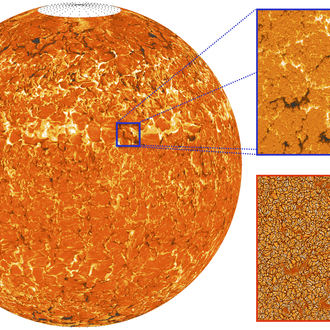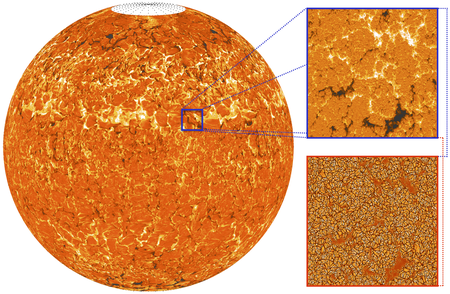Supercomputer to prove theory of sunspot formation

A global simulation of the Sun (left) cannot resolve the sunspot-formation processes while local high resolution simulations (right panels) can. Full caption in the text.
Credit: Petri KäpyläWhere do sunspots form? Just below the Sun’s surface or deep down inside? The SPOTSIM project, that studies the origin of sunspots using magnetohydrodynamic simulations has now been awarded competed time on the MareNostrum supercomputer in Spain.
Modelling the Sun is difficult and there are two competing models for how sunspots are formed. The common assumption has been that magnetic fields are thin tube-like structures originating at the bottom of the Sun's convection zone at a depth of 200,000 kilometres. From there they erupt to the surface and form sunspots. However, this model does not take turbulence into account. In the SPOTSIM project sunspots are believed to form near the Sun's surface, in its convection zone.
The project has been awarded 20 million CPU hours in the MareNostrum supercomputer in Barcelona through the 14th regular PRACE (Partnership for Advanced Computing in Europe) Tier-0 call. The allocation corresponds roughly to the combined yearly computing capacity of the local clusters at the Leibniz-Institute for Astrophysics (AIP).
“The project concentrates in testing a turbulent formation mechanism of sunspots. This would mean that sunspots are born near the solar surface instead of the currently prevailing paradigm.” describes researcher Petri Käpylä from the AIP in Germany and the Aalto University in Finland. „If this turns out to be true it will have far-reaching consequences for solar and stellar dynamo theory.”
Participants in the research project “SPOTSIM – Spot-forming convection simulations” include Petri Käpylä, Maarit Käpylä, Aalto University and the Max-Planck-Institute for Solar System Research, Nishant Singh and Jörn Warnecke, Max-Planck-Institute for Solar System Research, as well as Axel Brandenburg, Nordic Institute for Theoretical Physics (NORDITA) and the University of Colorado Boulder.
Image caption: A global simulation of the Sun (left) cannot resolve the sunspot-formation processes while local high resolution simulations (right panels) can. The top right panel shows the magnetic field and the lower panel shows the velocity. The blue box indicates the size of the local simulation. Image by: Petri Käpylä
Further information
Press release by the Aalto University:
http://www.aalto.fi/en/current/news/2017-05-10/
Science contact: Dr. Petri Juha Käpylä, +49 331-7499 525, pkapyla@aip.de
Images
A global simulation of the Sun (left) cannot resolve the sunspot-formation processes while local high resolution simulations (right panels) can. Full caption in the text.
Big screen size [1000 x 655, 1.3 MB]
Original size [2450 x 1605, 6.0 MB]



